Abstract
The activity of the hypothalamic gonadotrophin releasing hormone pulse generator in women with regular ovulatory and anovulatory menstrual cycles was assessed to see whether changes therein are important determinants of normal and impaired ovarian function. Endogenous gonadotrophin releasing hormone secretion was inferred by measurement of the pituitary luteinising hormone response by characterisation of pulsatile luteinising hormone release over eight hours on three occasions during the course of follicular development and once during the luteal stage of the same cycles. In 13 ovulatory cycles (serum progesterone concentration greater than 25 nmol/l) confirmed by ovarian ultrasonography a pronounced variability in luteinising hormone pulse patterns among subjects was compatible with ovulation. In the luteal stage of ovulatory cycles the luteinising hormone interpeak interval (85 min, range 42-125) was significantly longer than that during the early follicular (64 min, 40-103), mid-follicular (62 min, 37-107), and late follicular (59 min, 39-80) stages of the same cycles. Thus in ovulatory cycles no increase in frequency of the gonadotrophin releasing hormone pulse generator was detected during follicular development, though this activity decreased in the luteal stage. In five late follicular stage studies in which part of the preovulatory luteinising hormone surge was captured no change in pulse frequency of luteinising hormone was detected compared with the mid-follicular stage of the same cycles or when compared with the late follicular stage of other cycles when no luteinising hormone surge was captured. Though mean luteinising hormone concentrations in luteinising hormone surge series (36 IU/l) were high, the amplitude of luteinising hormone pulses (165%) was only slightly greater than during non-surge late follicular stage studies (145%). Hence no change in hypothalamic gonadotrophin releasing hormone activity is required to generate the preovulatory discharge of luteinising hormone in man, which occurs as a result of the sensitising action of rising oestradiol concentrations on pituitary responsiveness to the same hypothalamic input signal. Luteinising hormone pulse frequency, peak amplitude, and mean serum luteinising hormone concentrations in seven anovulatory cycles (progesterone concentration less than 10 nmol/l) were not different from those at comparable stages of ovulatory cycles. These data suggest that the primary abnormality in this group of regularly menstruating anovulatory women lies in the ovary rather than in the hypothalamic control of the anterior pituitary.
Full text
PDF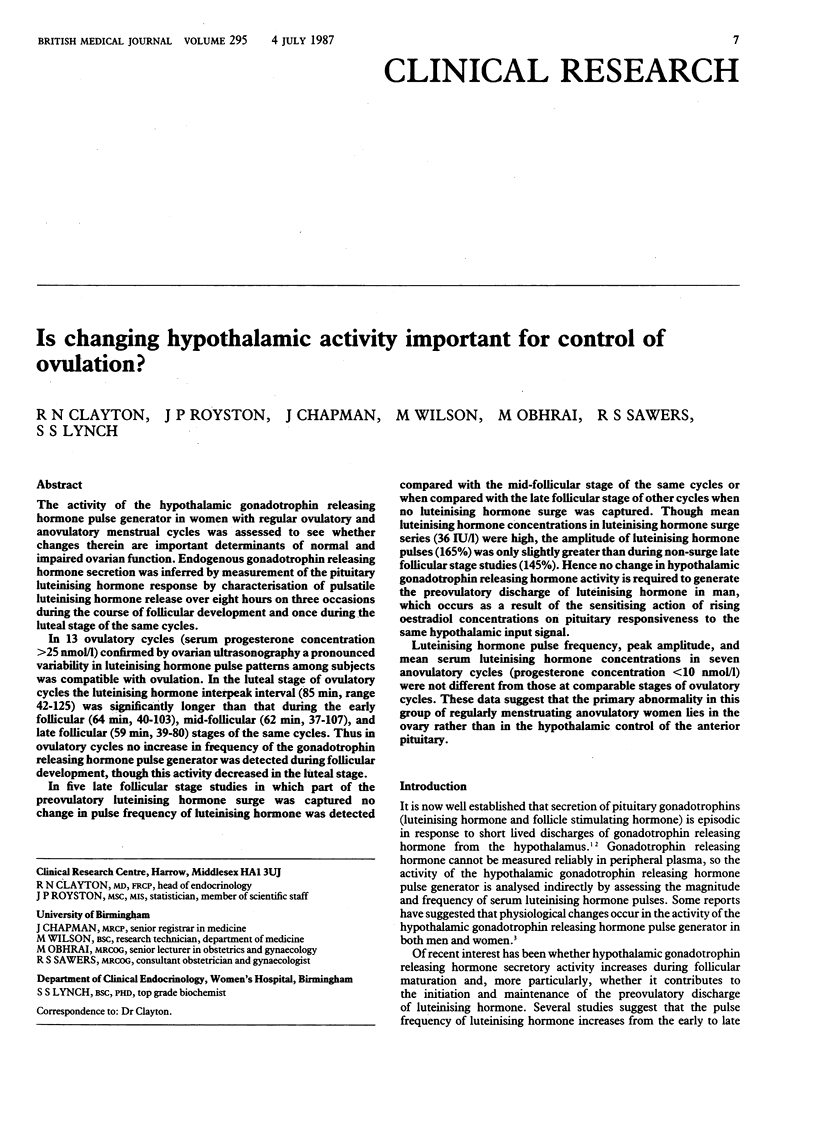
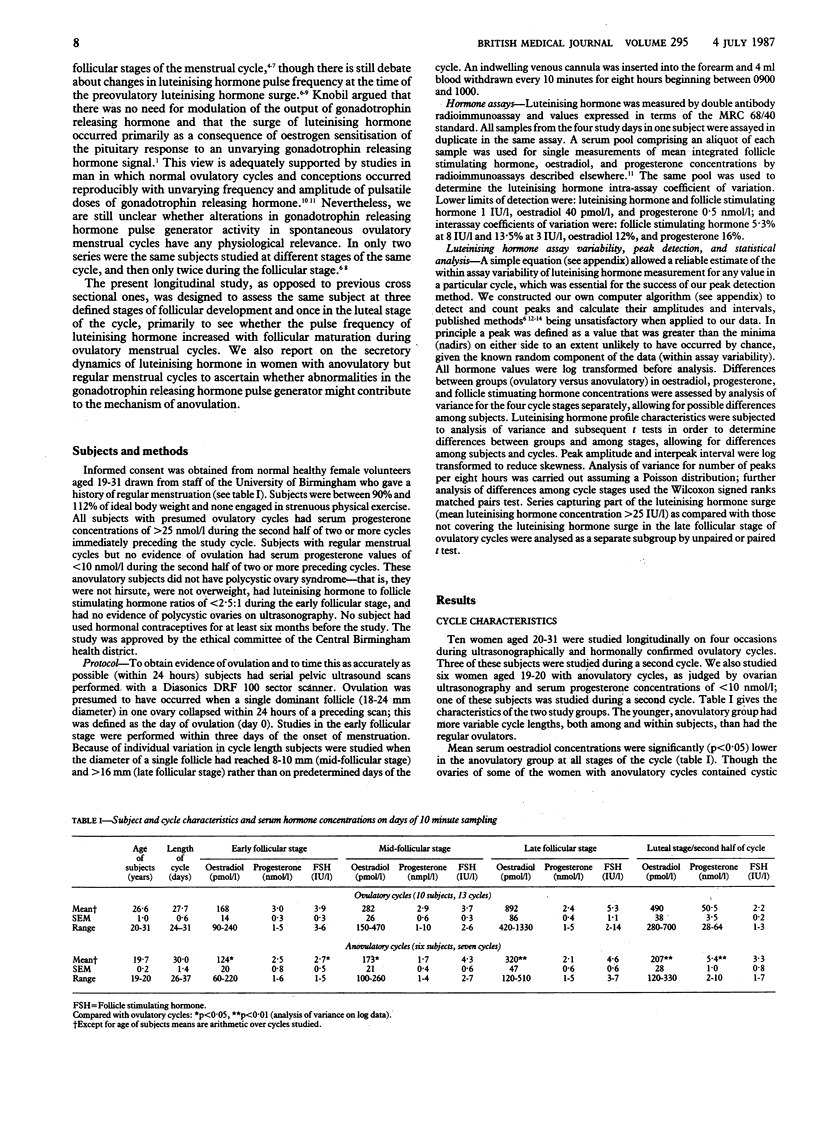
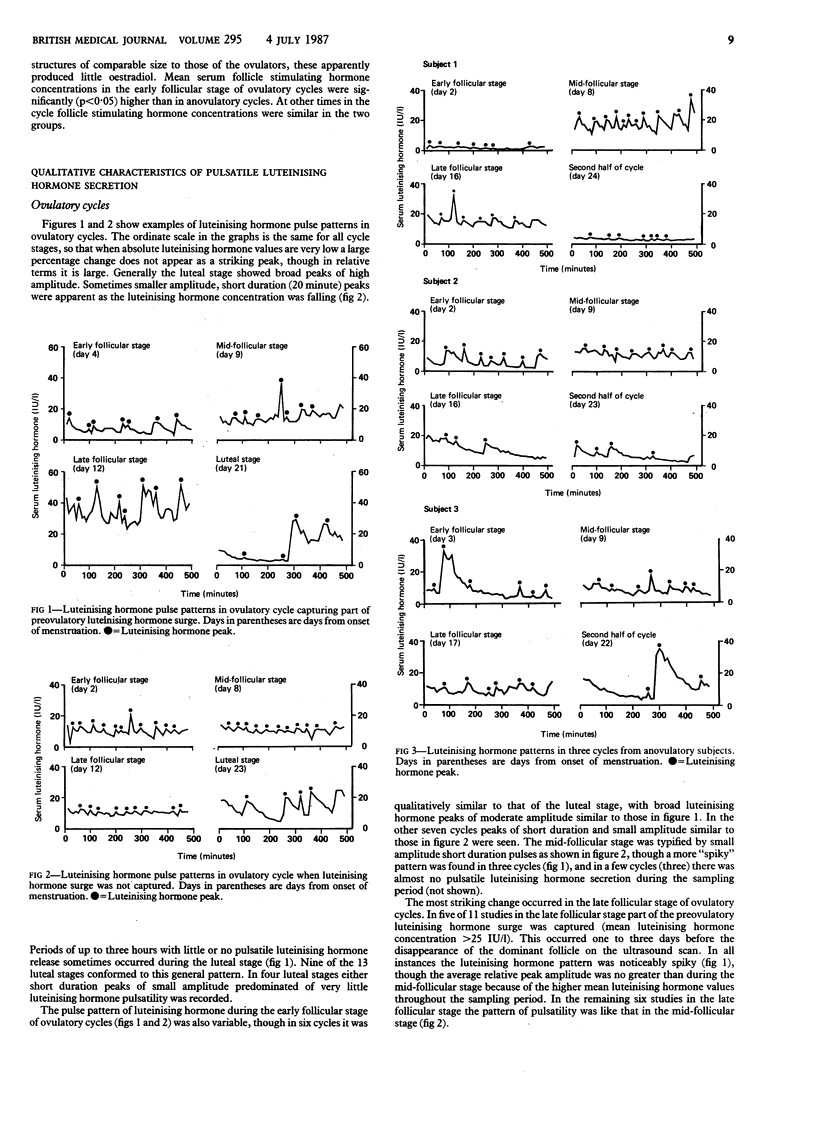
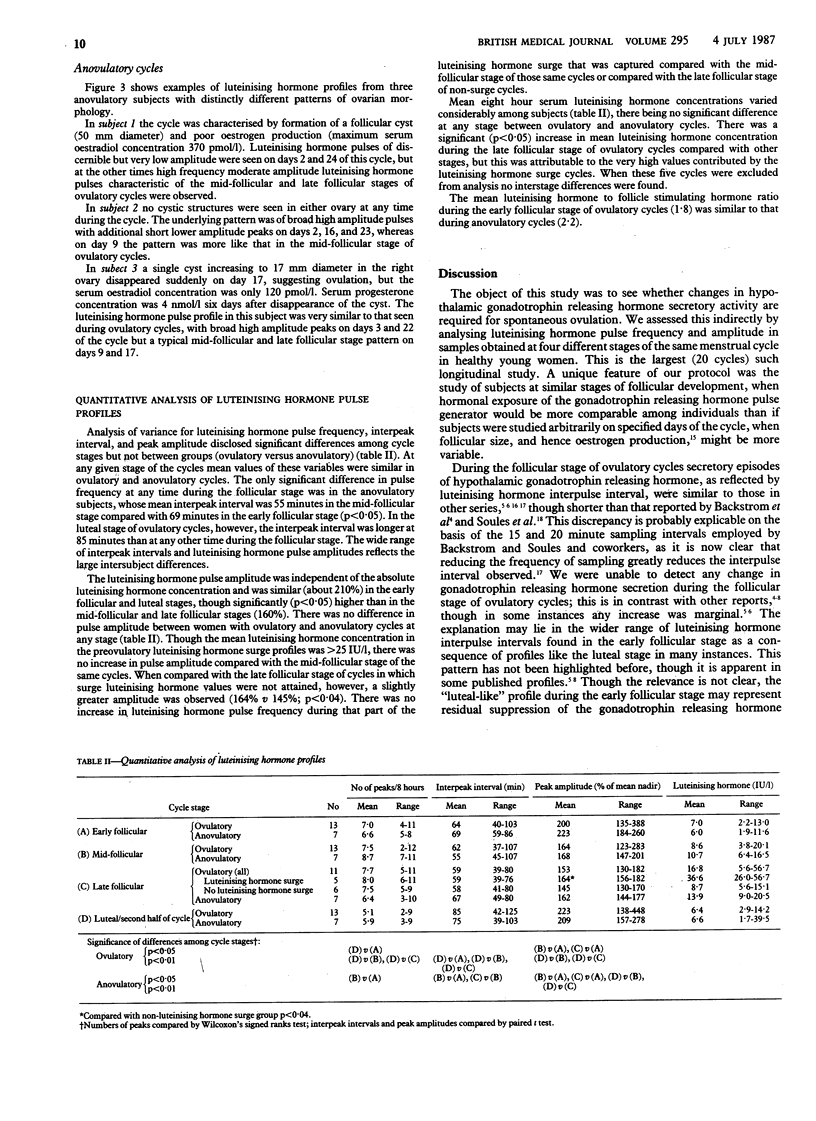
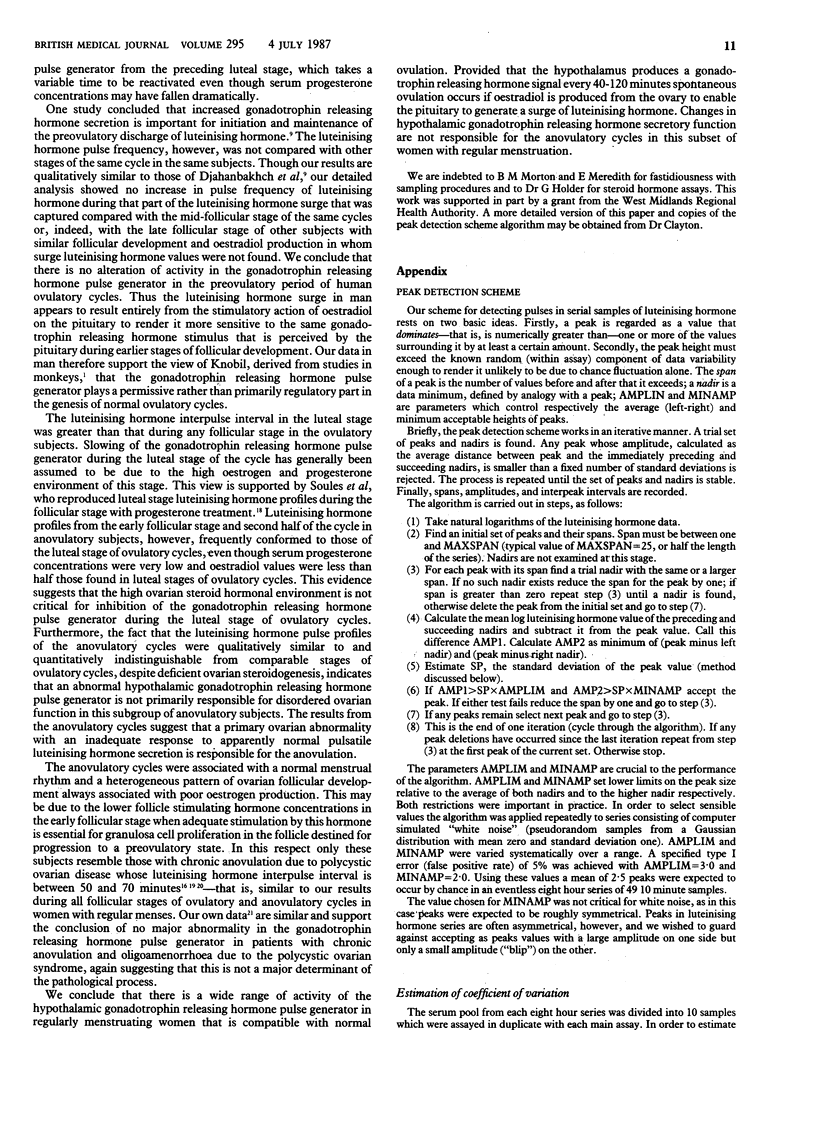
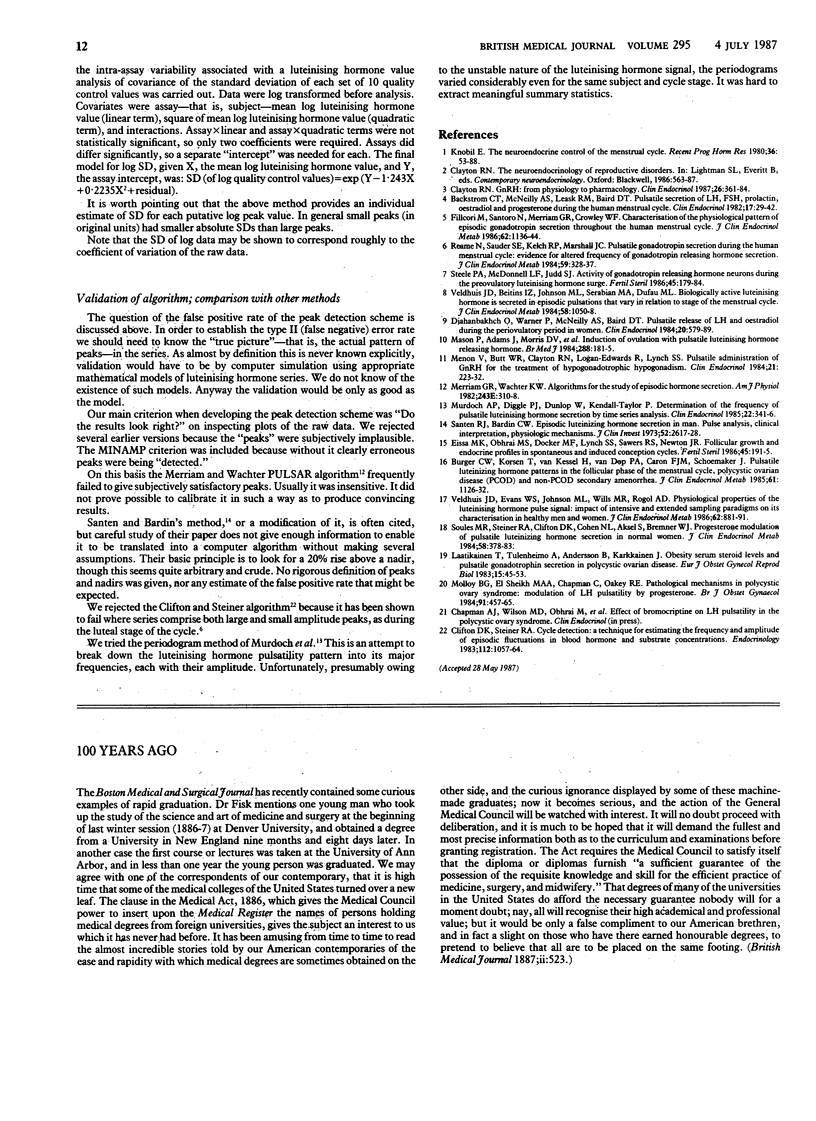
Selected References
These references are in PubMed. This may not be the complete list of references from this article.
- Burger C. W., Korsen T., van Kessel H., van Dop P. A., Caron F. J., Schoemaker J. Pulsatile luteinizing hormone patterns in the follicular phase of the menstrual cycle, polycystic ovarian disease (PCOD) and non-PCOD secondary amenorrhea. J Clin Endocrinol Metab. 1985 Dec;61(6):1126–1132. doi: 10.1210/jcem-61-6-1126. [DOI] [PubMed] [Google Scholar]
- Bäckström C. T., McNeilly A. S., Leask R. M., Baird D. T. Pulsatile secretion of LH, FSH, prolactin, oestradiol and progesterone during the human menstrual cycle. Clin Endocrinol (Oxf) 1982 Jul 1;17(1):29–42. doi: 10.1111/j.1365-2265.1982.tb02631.x. [DOI] [PubMed] [Google Scholar]
- Clayton R. N. Gonadotrophin releasing hormone: from physiology to pharmacology. Clin Endocrinol (Oxf) 1987 Mar;26(3):361–384. doi: 10.1111/j.1365-2265.1987.tb00794.x. [DOI] [PubMed] [Google Scholar]
- Djahanbakhch O., Warner P., McNeilly A. S., Baird D. T. Pulsatile release of LH and oestradiol during the periovulatory period in women. Clin Endocrinol (Oxf) 1984 May;20(5):579–589. doi: 10.1111/j.1365-2265.1984.tb00107.x. [DOI] [PubMed] [Google Scholar]
- Eissa M. K., Obhrai M. S., Docker M. F., Lynch S. S., Sawers R. S., Newton J. R. Follicular growth and endocrine profiles in spontaneous and induced conception cycles. Fertil Steril. 1986 Feb;45(2):191–195. doi: 10.1016/s0015-0282(16)49153-3. [DOI] [PubMed] [Google Scholar]
- Filicori M., Santoro N., Merriam G. R., Crowley W. F., Jr Characterization of the physiological pattern of episodic gonadotropin secretion throughout the human menstrual cycle. J Clin Endocrinol Metab. 1986 Jun;62(6):1136–1144. doi: 10.1210/jcem-62-6-1136. [DOI] [PubMed] [Google Scholar]
- Knobil E. The neuroendocrine control of the menstrual cycle. Recent Prog Horm Res. 1980;36:53–88. doi: 10.1016/b978-0-12-571136-4.50008-5. [DOI] [PubMed] [Google Scholar]
- Laatikainen T., Tulenheimo A., Andersson B., Kärkkäinen J. Obesity, serum steroid levels, and pulsatile gonadotropin secretion in polycystic ovarian disease. Eur J Obstet Gynecol Reprod Biol. 1983 Apr;15(1):45–53. doi: 10.1016/0028-2243(83)90296-4. [DOI] [PubMed] [Google Scholar]
- Mason P., Adams J., Morris D. V., Tucker M., Price J., Voulgaris Z., Van der Spuy Z. M., Sutherland I., Chambers G. R., White S. Induction of ovulation with pulsatile luteinising hormone releasing hormone. Br Med J (Clin Res Ed) 1984 Jan 21;288(6412):181–185. doi: 10.1136/bmj.288.6412.181. [DOI] [PMC free article] [PubMed] [Google Scholar]
- Menon V., Butt W. R., Clayton R. N., Edwards R. L., Lynch S. S. Pulsatile administration of GnRH for the treatment of hypogonadotrophic hypogonadism. Clin Endocrinol (Oxf) 1984 Sep;21(3):223–232. doi: 10.1111/j.1365-2265.1984.tb03463.x. [DOI] [PubMed] [Google Scholar]
- Molloy B. G., El Sheikh M. A., Chapman C., Oakey R. E., Hancock K. W., Glass M. R. Pathological mechanisms in polycystic ovary syndrome: modulation of LH pulsatility by progesterone. Br J Obstet Gynaecol. 1984 May;91(5):457–465. doi: 10.1111/j.1471-0528.1984.tb04784.x. [DOI] [PubMed] [Google Scholar]
- Reame N., Sauder S. E., Kelch R. P., Marshall J. C. Pulsatile gonadotropin secretion during the human menstrual cycle: evidence for altered frequency of gonadotropin-releasing hormone secretion. J Clin Endocrinol Metab. 1984 Aug;59(2):328–337. doi: 10.1210/jcem-59-2-328. [DOI] [PubMed] [Google Scholar]
- Santen R. J., Bardin C. W. Episodic luteinizing hormone secretion in man. Pulse analysis, clinical interpretation, physiologic mechanisms. J Clin Invest. 1973 Oct;52(10):2617–2628. doi: 10.1172/JCI107454. [DOI] [PMC free article] [PubMed] [Google Scholar]
- Soules M. R., Steiner R. A., Clifton D. K., Cohen N. L., Aksel S., Bremner W. J. Progesterone modulation of pulsatile luteinizing hormone secretion in normal women. J Clin Endocrinol Metab. 1984 Feb;58(2):378–383. doi: 10.1210/jcem-58-2-378. [DOI] [PubMed] [Google Scholar]
- Steele P. A., McDonnell L. F., Judd S. J. Activity of gonadotropin-releasing hormone neurons during the preovulatory luteinizing hormone surge. Fertil Steril. 1986 Feb;45(2):179–184. [PubMed] [Google Scholar]
- Veldhuis J. D., Beitins I. Z., Johnson M. L., Serabian M. A., Dufau M. L. Biologically active luteinizing hormone is secreted in episodic pulsations that vary in relation to stage of the menstrual cycle. J Clin Endocrinol Metab. 1984 Jun;58(6):1050–1058. doi: 10.1210/jcem-58-6-1050. [DOI] [PubMed] [Google Scholar]
- Veldhuis J. D., Evans W. S., Johnson M. L., Wills M. R., Rogol A. D. Physiological properties of the luteinizing hormone pulse signal: impact of intensive and extended venous sampling paradigms on its characterization in healthy men and women. J Clin Endocrinol Metab. 1986 May;62(5):881–891. doi: 10.1210/jcem-62-5-881. [DOI] [PubMed] [Google Scholar]


